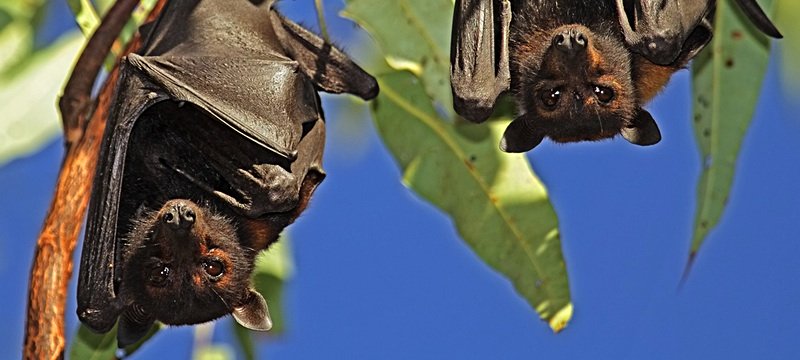Bats are incredible mammals that make up a quarter of all mammal species on Earth. Let’s meet some interesting facts about bats!
1.
Bats have extremely elongated fingers and a wing membrane stretched between, and they are the only mammals truly capable of actual flight.
2.
Over 1,000 species of bats can be found all over the planet and vary in color and size.
3.
Bats mainly consume insects and serve as a natural pest control for the world. Aside from insect-eating bats, there are also some bats that obtain their nutrients from fruits, nectar, fish, and other small mammals. There are also the famous blood-sucking vampire bats, which live primarily in South America.
4.
Bats are nocturnal mammals, which mean they are mostly active during the night. This is when they do most of their feeding and communication with other bats.
5.
Bats have a special way of communicating called echolocation, in which they make noises and wait for the sound waves to bounce back to them. From the sound waves, they can tell the distance of various objects by how quickly the sound waves bounce back to them.
6.
Bats are usually divided into two major groups, the megabats and the microbats. Megabats are a grouping of bats that do not use echolocation, while microbats, on the other hand, do use echolocation.
7.
Megabats mainly feast on fruit, nectar, and pollen, while microbats eat insects. Megabats are typically larger than microbats, with a few exceptions.
8.
Microbats lack the claw at the second finger of the forelimb, unlike megabats, and they lack underfur; they are either naked or have guard hairs to protect their bodies.
9.
There are a few fossilized remains of bats that show the structures of wings and long tails. The longer tails kept prehistoric bats on a stable course. The tail grew shorter and shorter with evolution and eventually, bats established the mental capability to keep a stable course without a longer tail.
10.
Most, if not all, bats rest, sleep, and hibernate in an upside-down position. This means they hang onto branches or rocks with their feet and hang down.
11.
Bats are equipped with a locking mechanism on the tendons in their feet, which keeps them from slipping. The tendons are a great advantage to bats, seeing as the energy bats spend on hanging is greatly reduced. Once the tendons are locked, the muscles in their legs and feet can relax.
12.
The dung of bats, known as guano, is so rich in nutrients that it is mined from caves and bagged to send to farmers as fertilizer for crops. During the U.S. Civil War, guano was used to make gunpowder for Union and the Confederacy.
13.
Most bats reproduce in the spring season and can have one to three litters per season, depending on the breed and the temperature.
14.
Females generally have one offspring at a time, which is the result of the mother’s need to fly to feed while pregnant.
15.
Female bats nurse their young until they almost reach adulthood, as a young bat can’t live on its own until its wings are fully developed.
16.
While bats can live up to, and sometimes over, 20 years of age, the bat population growth is limited by the slow birth rate.
17.
Unusual species of bats include fruit bats, which mainly feast on fruits. Vampire bats live in Latin America and are globally famous for drinking only blood. Greater Noctule bats hunt birds, which is different from other bats, who mainly eat insects. The Fisherman bat thrives in the Caribbean and swoops low over the water, using its small, sharp claws to grab fish that swim just under the surface.
18.
The Bumblebee bat is the world smallest bat, weighing in at 2 grams and measuring out from 29 to 33 millimeters. This kind of bat lives primarily in Thailand and is also one of the world’s smallest mammals.
19.
The largest bat is known as the Giant golden-crowned flying fox (Acerodon jubatus), a rare fruit bat and endangered species. The wingspan may be almost 1.8 meters and weighs about 1.5 kilograms.
20.
The Christmas Island Pipistrelle is the only bat that has gone into extinction. The Christmas Island Pipistrelle was a species of bat that only lived on Christmas Island, off the coast of Australia. Scientists do not know why the Pipistrelle’s numbers dropped, but suggestions included unknown diseases and being targeted by other animals, like snakes and cats.
21.
In the United Kingdom, bats are protected under law. Disturbing a bat or its roost can be punished with a heavy fine.
22.
In Austin, Texas, United States, nearly 1.5 million Mexican free-tailed bats conjugate under the Congress Avenue bridge during the summer months. This draws thousands of tourists to Austin each year.
23.
In Malaysia, most bat species are protected under law, but others, like the large naked bat and the Greater Nectar bat are eaten by the local.
24.
In folklore, bats are mostly associated with vampires, who are said to be able to change into bats. Bats often represent death, ghosts, disease, and bad luck, but are good omens in some countries, like Poland.
25.
The bat is used in fiction quite a lot and is played out as both the hero and the villain. Dracula was one of the first vampire villains that struck fear into the hearts of millions, and Batman is a popular hero who dresses like a bat to save his city from crime. Other novelists, like Anne Rice, have written vampires into their books, and horror films often feature vampires as main or minor characters.
